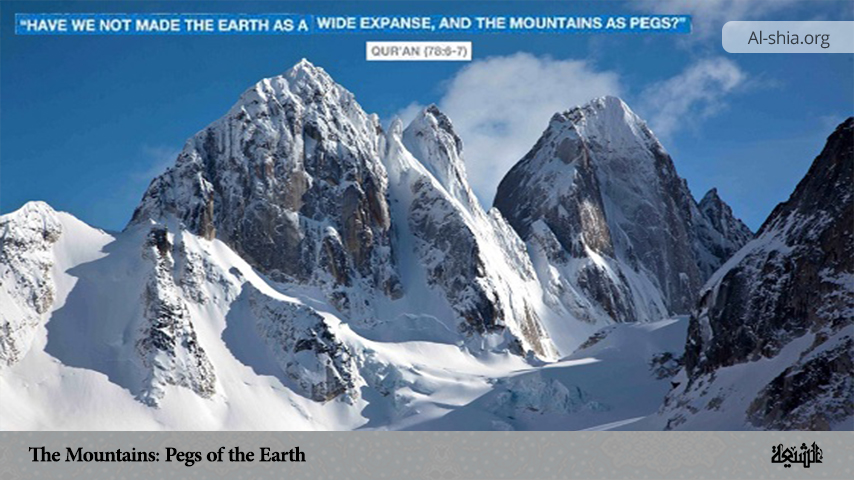The glorious Qur’an has a particular conception of the nature of mountains, their formation, and the geological role they play. For instance, it is mentioned in the Holy Qur’an that:
“The mountains which you take to be firm will pass away like clouds” (27: 88)
And:
“Did we not spread the earth like a bed and raise the mountains like pegs” (78:7).
In pre-historic times man used to live in caves and take shelter in them. He did not know how to build houses until the end of the Stone Age. And, he used to live in caves or dig such shelters to protect himself from the wrath of nature and its fluctuations; like the cold, the snow, the rain, and the heat as well as floods and hurricanes, and to protect himself against beasts and wild animals. The Quran expresses these meanings in the following verses:
“They hewed their dwellings into the mountains and lived in safety” (15:82)
Also:
“I shall seek refuge in a mountain which will protect me from the flood” (11:43).
The mountains are an integral part of the solid shell of the earth (The crust). If the crust shakes or if the earth trembles the mountains will shake too.
“The day when the earth shakes with all its mountains” (73:14)
The mountains’ rocks contain all kinds of metals, such as gold, silver, copper, iron… e.t.c.
“In the mountains, there are streaks of various shades of red and white, and jet-black rocks” (35:27)
The rotation of the mountains although they seem to be unmoving, indicates that earth too is rotating and travelling in vast space.
“The mountains which you take to be firm will pass away like clouds” (27:88)
One of the most important functions of the mountains is to hold together the solid outer layers of the crust of the earth, in the same way, the pegs hold the tents and act as the pillars that support them:
“Did We not spread the earth like beds and raise the mountains like pegs” (78:7)
Mountains also help in preserving the stability of the earth’s crust. As we know the crust undergoes an ongoing change as a result of many factors. This change creates a state of instability between its rising parts (the mountains) and its falling ones (the seas), which creates earthquakes and causes volcanoes to erupt.
“We set firm mountains upon the earth lest it should move away with you;” (16:15)
And now let us take a look at the surface of the earth with all its mountains, seas, valleys, rivers, deserts, gulfs…etc.
Do you think that they are all fixed in their places? Furthermore, do you believe that they are still the same as Allah, the Most Exalted, founded them? Alternatively, do they transform and change? The fact that we ought to know and keep in mind is that the surface of the earth is in a state of constant change, but one that is so slow that it cannot be noticed in thousands of years.
The slow changes take place due to the activity of a number of atmospheric and natural factors, the most important of which is the differences in temperatures whether between day and night or between winter and summer which cause the earth’s crust to crack and crumble.
Winds, rains, floods, rivers. and waves play also an important role in eroding the rocks and carrying the crumbled particles to lower sea depths, where they form sedimentary lavers.
These factors are called eroding factors, which play an amazingly contradictory role; for it erodes on the one hand and forms new rocks on the other hand.
In this context, we can distinguish four distinct kinds of rocks, according to the way they were formed:
1- Igneous Rocks: such as granite and Basalt.
2- Sedimentary Rocks: such as limestone and sandstone.
3- Transformed Rocks: These rocks were originally igneous or sedimentary rocks but were transformed by heat, pressure and other factors, and changed into marble, slate or other such rocks.
It is generally admitted nowadays that the face of the earth did not remain the same throughout the ages. Rather it has undergone, as we mentioned above, an on-going process of change in which the eroding factors were able to wipe out mountains and fill its sediments at the depths of seas and oceans.
These sedimentary layers will cause floods that would overflow the continents carrying with them various precipitates, which the land cannot carry, their weight. Consequently, a new phase of the geological cycle would be initiated, in the form of an unruly revolution that would end in the formation of new mountains, which in turn will be subjected to the same natural factors, and the whole circle will be repeated again.
The most recent revolutions are the ones that resulted in the formation of the Himalayas and the Alps mountains, which are young mountains that have not been subjected yet to the ruining and destruction factors.

















